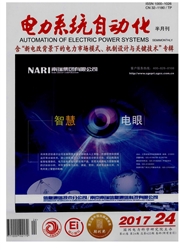

 中文摘要:
中文摘要:
现有的光学电压互感器(OVT)大多基于电光晶体的Pockels效应,即电光晶体在外加电场的作用下其折射率发生变化,使得沿某一方向射入晶体的线偏振光产生电光相位延迟,延迟量与外加电场成正比。由于无法实现对晶体电光相位延迟的直接测量,通常采用偏光干涉测量模式,将相位延迟转变为光强调制,通过对光强的检测实现电压测量。这种测量模式反映了光功率的大小,但仅能近似线性地测量有限的电光相位延迟,其稳定性与可靠性受到温漂、晶体附加相位延迟、半波电压等问题的限制,无法满足电力系统的实用要求。文中分析了偏光干涉测量模式的局限性,并对双光路补偿法进行了讨论。
 英文摘要:
英文摘要:
The optical voltage transducer (OVT) is mainly based on the Pockels effect of an electro-optic crystal. According to the Pockels effect, the refractive index of crystal will change under the action of an applied electric field. This change will then make the linearly polarized light injected into the crystal along a certain direction generate an electro-optic phase delay that is proportional to the applied electric field. Since the electro-optic phase delay can not be directly acquired, the polarization interference measuring model is always employed. It converts an electro-optic phase delay into the voltage to be measured with light intensity modulation. Such a measuring mode, being dependent on light power detection, can only realize approximate linear measurement of limited phase delay. And, restricted by the temperature drift, the additional phase delay and half-wave voltage, the stability and reliability of OVT cannot meet the service requirements of the power system. This paper analyzes the limitations of polarization interference measuring mode and discusses the double optic route method.
 同期刊论文项目
同期刊论文项目
 同项目期刊论文
同项目期刊论文
 Research on Characteristics of Axially Symmetric Polarized Beams with a Nanometer Subwavelength Meta
Research on Characteristics of Axially Symmetric Polarized Beams with a Nanometer Subwavelength Meta 期刊信息
期刊信息
